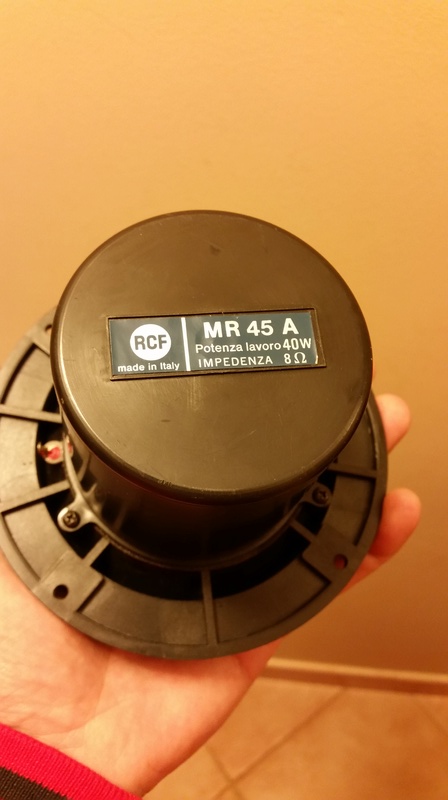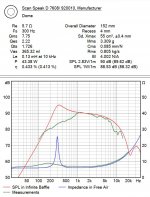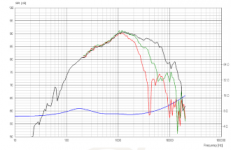Hello guys ,
Does anyone know the Thiele & Small Parameters of these old mid range? On the net do not find any news of them ..... thank you

Does anyone know the Thiele & Small Parameters of these old mid range? On the net do not find any news of them ..... thank you

As you have the driver, why not just measure them ?
... I do not have specific tools ..! For measure
MR45A is a dome midrange with closed back, you don't need TS parameters to design a crossover. However, you do need to measure the frequency response and impedance vs frequency to design a crossover. ARTA software is free, borrow microphone and do the measurements, or ask someone to do that.
MR45A is a dome midrange with closed back, you don't need TS parameters to design a crossover. However, you do need to measure the frequency response and impedance vs frequency to design a crossover. ARTA software is free, borrow microphone and do the measurements, or ask someone to do that.
thanks for your advice.....
For measuring the TSP on a dome driver you have to be very precise and delicate, you cannot add mass for measuring and the volume change method only gives you a kinda estimate, you can't exactly measure the volume within the driver itself (not the back chamber).
But having the parameters does not give you much to work with. What for do you need it? What do you want to accomplish? The things you can do are limited. You could probably change the back volume but that's already at the maximum usable size, increasing it further might lower the fs a few % but that's not the limit of the driver to go lower, it's the distortion and maximum excursion ( <0,5mm ). And you don't need the TSP for that either.
But having the parameters does not give you much to work with. What for do you need it? What do you want to accomplish? The things you can do are limited. You could probably change the back volume but that's already at the maximum usable size, increasing it further might lower the fs a few % but that's not the limit of the driver to go lower, it's the distortion and maximum excursion ( <0,5mm ). And you don't need the TSP for that either.
For measuring the TSP on a dome driver you have to be very precise and delicate, you cannot add mass for measuring and the volume change method only gives you a kinda estimate, you can't exactly measure the volume within the driver itself (not the back chamber).
But having the parameters does not give you much to work with. What for do you need it? What do you want to accomplish? The things you can do are limited. You could probably change the back volume but that's already at the maximum usable size, increasing it further might lower the fs a few % but that's not the limit of the driver to go lower, it's the distortion and maximum excursion ( <0,5mm ). And you don't need the TSP for that either.
... I wanted to know the parameters of it to create a crossover ..... just this!
You can't create a crossover from the parameters. Who told you that? Not only do the parameter say nothing about the behaviour or the response, distortion or where to cross it over. They are ONLY relevant if you use a driver in the range around the Fs. And that is totally out of the question for these dome drivers. You cannot draw any conclusion out of them except a crude estimate of the impedance.
You can't create a crossover from the parameters. Who told you that? Not only do the parameter say nothing about the behaviour or the response, distortion or where to cross it over. They are ONLY relevant if you use a driver in the range around the Fs. And that is totally out of the question for these dome drivers. You cannot draw any conclusion out of them except a crude estimate of the impedance.
..escus me, but parameters like FS, frequency response and sensitivity (db) are not useful for crossover calculation? ...
..escus me, but parameters like FS, frequency response and sensitivity (db) are not useful for crossover calculation? ...
For a midrange the FS is not directly relevant, it can only give you a rough estimate. The frequency response isn't part of the TSP and the sensitivity can only be very roughly calculated at cone drivers around the fs, how much they rise in the actual midrange however, it can not. So no, it does not help.
And you can't 'calculate' the crossover in any way to get to a good sounding speaker, that depends on a lot more things like the radiating pattern (response at angles, not part in the TSP), the baffle step (depending on the baffle size, not in the TSP), the distortion (not in the TSP), the decay (not in the TSP), the distortion (not in the TSP), membrane and surround resonances (not in the TSP, don't confuse that with the fs), the driver and membrane geometry (not in the TSP), membrane breakup (not in the TSP), the power handling (not in the TSP) and the response (..yes, you guessed it right, not in the TSP either).
Have you never thought about why dome speakers hardly ever got TSP specs? This is why:
"Thiele/Small parameters (commonly abbreviated T/S) are a set of electromechanical parameters that define the specified low frequency performance of a loudspeaker driver." (Wikipedia)
ICG, that's a bit of a one-eyed optic IMO. If someone isn't equipped to do measurements, how is he supposed to design a basic crossover without having the TSP of the drivers?
In the context of simulation programs TSP are always required, not just for woofers. In most cases, the frequency response in the pistonic range can be calculated pretty precisely then. That's about 2 kHz for a 40 mm dome. Above 2 kHz things get more complicated though.
Fs is highly relevant in crossover design, since the impedance peak can ruin the high-pass filter completely.
I have no TS-parameters for that midrange either, but here is a crossover for the MR45: Manuale autoCostruzione RCF...induttanza??
In the context of simulation programs TSP are always required, not just for woofers. In most cases, the frequency response in the pistonic range can be calculated pretty precisely then. That's about 2 kHz for a 40 mm dome. Above 2 kHz things get more complicated though.
Fs is highly relevant in crossover design, since the impedance peak can ruin the high-pass filter completely.
I have no TS-parameters for that midrange either, but here is a crossover for the MR45: Manuale autoCostruzione RCF...induttanza??
Id say get a cheap measurement system like the dayton umm6 usb.
then measure the driver in the intended cabinet.
That should give all you need to model in free software to work out xovers.
It should at least give you a good starting point.
then measure the driver in the intended cabinet.
That should give all you need to model in free software to work out xovers.
It should at least give you a good starting point.
ICG, that's a bit of a one-eyed optic IMO. If someone isn't equipped to do measurements, how is he supposed to design a basic crossover without having the TSP of the drivers?
In the context of simulation programs TSP are always required, not just for woofers. In most cases, the frequency response in the pistonic range can be calculated pretty precisely then. That's about 2 kHz for a 40 mm dome. Above 2 kHz things get more complicated though.
Fs is highly relevant in crossover design, since the impedance peak can ruin the high-pass filter completely.
I have no TS-parameters for that midrange either, but here is a crossover for the MR45: Manuale autoCostruzione RCF...induttanza??
... this is an old RCF Construction Manual, I found it on the net, there is a crossover project with expected midrange MR45 .... but it's not very clear ... see inductance ... precisely! ... ... sure the dayton umm6 usb is a solution ... expensive costume !!
You could measure basic TS parameters using some wires with alligator clips. Fs and Qts would have sufficed to get the picture. Depicted in the schematic of post #2 with ARTA labs LIMP module software. There is also explained how to measure Re, the DC resistance of the dirver voice coil.
http://www.diyaudio.com/forums/multi-way/308279-repurposing-wall-speakers.html
http://www.diyaudio.com/forums/multi-way/308279-repurposing-wall-speakers.html
Last edited:
ICG, that's a bit of a one-eyed optic IMO. If someone isn't equipped to do measurements, how is he supposed to design a basic crossover without having the TSP of the drivers?
No, it isn't. Firstly, you can not calculate a crossover from the TSP. AT ALL. And if you can't measure, you can still design a crossover with only your ears. But that requires experience, which he obviously does not have. That said, he is most likely overburdened with a 3 way speaker anyway.
But 'no measurement equipment' is no argument. You can build your own microphone for ~10 bucks.
In the context of simulation programs TSP are always required, not just for woofers.
If it's a cone midrange, yes, probably (but not always). But this is a DOME midrange.
In most cases, the frequency response in the pistonic range can be calculated pretty precisely then. That's about 2 kHz for a 40 mm dome. Above 2 kHz things get more complicated though.
No, it can't. You can't calculate the membrane breakup, the angle response and everything else I've already wrote several times above. Honestly, I'm sick and tired in repeating myself over and over again just because some don't even try learning the meaning of the parameters and what you can do with them and what not.
You're still saying 'I can calculate it'? Okay, then calculate me a crossover with this midrange:
Qms 7,75
Qes 2,22
Qts 1,73
fs 300 Hz
Mms 3,3 g
Sd 55 cm²
Vas 0,36l
Re 5,7 Ohm
Le 0,13mH
Fs is highly relevant in crossover design, since the impedance peak can ruin the high-pass filter completely.
Yes, and I've said you'd probably need the fs. But you can't calculate with that anyway.
I have no TS-parameters for that midrange either, but here is a crossover for the MR45: Manuale autoCostruzione RCF...induttanza??
Oh, nice! One coil, one capacitor. Now tell me where that 6dB crossover took care of the fs or needed the TSP?
Well, if parameters are completely wrong then the simulation is wrong as well. Are you trying to fool me? Nevertheless, in the range from 1 kHz to 6 kHz the simulation is very close to the measurement. Close enough to do a basic crossover design in a simulation program. 🙂
Attachments
Are you trying to fool me? Nevertheless, in the range from 1 kHz to 6 kHz the simulation is very close to the measurement. Close enough to do a basic crossover design in a simulation program. 🙂
No, I just wanted to demonstrate how useless these parameters are (for a dome driver). Not only will they have huge tolerances even at top manufacturers, they rarely available and volume resonances aren't anywhere noticeable, they are extremely misleading. So you came to the conclusion the 1-6kHz range is close enough to do a crossover design. Now look at the datasheet, would you really use the mid driver in that frequency range?
Do you see now how 'useful' the parameters were?
Attachments
scusate , non volevo scatenare l'inferno....!!! effettivamente esso è un mid/range in sua scatola chiusa , quindi basta conoscere la risposta in frequenza...per esso lavorare bene ....quindi con taglio basso 1K e alto 6K ...?
Sorry, I did not want to unleash hell .... !!! In fact it is a mid / range in its closed box, so just know the frequency response ... for it to work well ... so with low cut 1K and high 6K ...?
- Status
- Not open for further replies.
- Home
- Loudspeakers
- Multi-Way
- RCF MR45 A ...Parameters?

